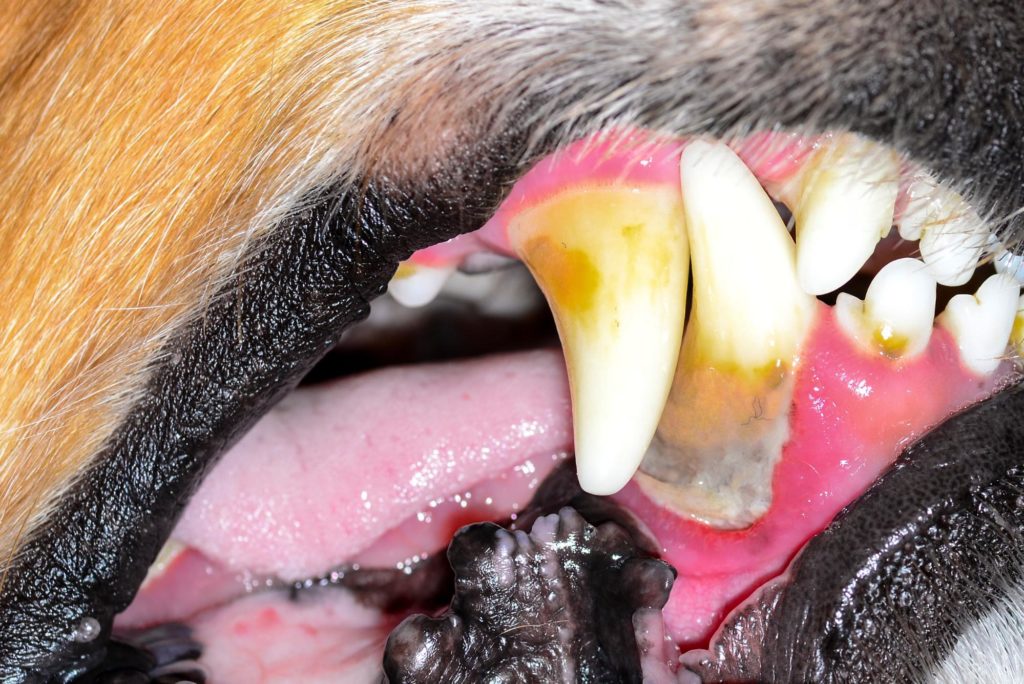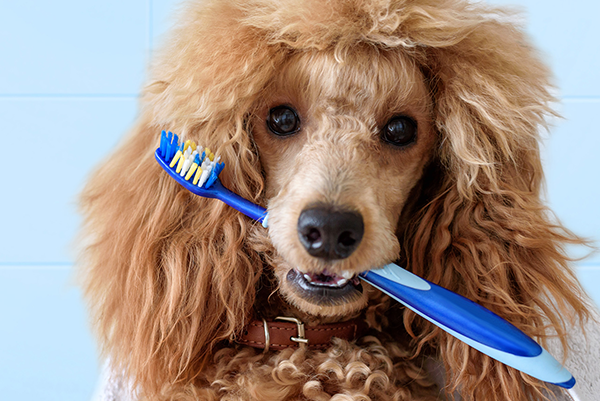This February we are focusing on Pet Dental Month! This month many Vet practices and companies will give discounts on procedures, products, and exams to help your pet have the best possible smile! Here are some great times about your pets pearly whites!
Interesting facts about your pet’s Teeth!

Dogs Go Through Two Sets of Teeth in Their Lifetime – Just like people have baby teeth, dogs have puppy teeth that are later replaced. Puppy teeth—also known as deciduous teeth or milk teeth—work much like an adult dog’s teeth but on a smaller scale. Beginning at 4 months and ending around 6 months the baby teeth are replaced with adult teeth!
Adult Dogs Have More Teeth Than Humans – Adult dogs have 42 teeth. Most people have 32. Adult cats have 30 teeth.
Dogs Use Their Teeth Differently Than Humans – While the makeup and chemical structure of dog teeth are similar to those of human teeth, the size and shape of dog teeth are where the biggest differences come into play. The most prominent teeth are the long and pointy canines. They are used for grasping, lifting, pulling and potentially for defense. Further back in the mouth, the large carnassial teeth are designed to shear against one another, to provide a slicing action.
What types of teeth does a dog have?
Just like humans, dogs have a number of different types of teeth. These different teeth perform different jobs and help dogs to break down food whilst chewing. Every dog has the following types of teeth in their mouth:
Incisor
Incisors are the small teeth found at the front of a dog’s mouth. They are used for scraping, as their shape makes them ideal for trying to scrape meat from bones. Dogs also use their incisors when grooming themselves. Dogs often try to remove fleas and ticks by nibbling at their coat and using their incisors to pick out and kill parasites.
Canine
Canines are the long and pointed teeth found towards the front of your dog’s mouth, behind its incisors. These teeth are used for tearing food such as meat apart. They are also used to lock on to an item a dog may have in its mouth, such as a bone or chew toy. Dogs grow four canine teeth, two on both the bottom and upper jaw.
Pre–Molar
Pre-molars are the sharp-edged teeth found behind a dog’s canines. They are usually used to chew and shred any food a dog may be eating. You may notice your dog chewing a meaty bone with the side of their mouth; this is so their pre-molars shred the meat away from the bone.
Molar
Molars are used to break down any hard foods that your dog has to chew. This includes dry dog kibble and tough dog biscuits. These molars are found behind a dog’s pre-molars, and they are the furthest teeth back in a dog’s jaw.
Some keys to proper care!
Healthy dog teeth should be clean and free of plaque and tartar, hard, scaly or sticky discolorations. Your furry friend’s tongue should be moist without any signs of lumps or cuts. And, in most cases, his gums should be salmon pink.
Regular brushing with a dog-specific toothbrush and toothpaste helps, and so do certain toys and treats that are formulated to reduce bacteria in your pet’s mouth. Another important part of dog oral care is an annual professional cleaning at your vet’s office. This procedure should be done under anesthesia, every one to three years.
If brushing your pet’s teeth isn’t something you can or want to do giving a regular chew that can help break down plaque is a great way to help keep your pet’s teeth in tip-top shape between cleanings. Many of these Vet approved chews will help reduce plaque and bad breath and are fully digestible!
Troubled Teeth Things to look out for!
Halitosis: Bad breath (or halitosis) may be the first sign of a problem with your pet’s oral health. Halitosis occurs when bacteria from food get stuck in your dog’s mouth. An infection may also be the cause here.

Cysts and tumors: If there are any irregular or bumps or lumps you have just noticed, make an appointment to get your pet examined right away. While some lumps and bumps are of no concern, those found in your dog’s mouth may represent a cyst or tumor. Some cysts may need to be drained by your vet, and lumps should be biopsied and removed if they are malignant.
Gingivitis: Inflamed gums caused by heavy plaque on your pet’s teeth are often a sign of gingivitis. If you notice any bleeding or changes in gum color, contact your vet.
Periodontal disease: Periodontal disease is an infection between the teeth and gums that can cause swelling, loose teeth, pain, difficulty eating, or even nasal discharge. Look for signs like yellow or brown teeth, red or swollen gums and difficulty chewing. If your dog shows any of these or other signs of loose teeth or mouth pain, take him to your vet. He or she will likely examine your pet to look for signs of infection, and your dog may need to be put on a treatment plan.


